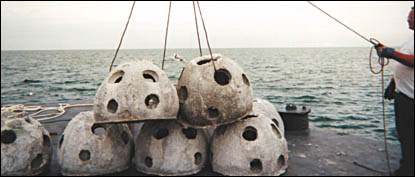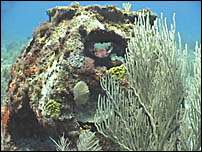|

Volume XIII, Number 1
January-February
2002
CONTACTS
Eternal Reefs
Tel:
(888) 423-7333
Reef
Relief
Tel: (305) 294-3100
Natural Death
Centre
Tel: 011-44-20-8-2853 |
IN BRIEF
Green
Burial at Sea?
By Jason G. Daley
Cremation is growing dramatically in the United States, tripling since
1972 to almost 600,000 funerals per year. By 2010, the procedure may be
part of 40 percent of funerals, according to the Cremation Association of
North America. With this increase, disposing of cremated human remains in
meaningful ways has become a challenge. During the past decade, creative
souls have launched ashes into orbit, stuffed them into duck decoys and
blown them into designer glassware. Now, an Atlanta-based company offers
what they say is an ecologically friendly and lasting solution that
incorporates cremated remains into artificial reefs.
 |
Would you like your cremated remains molded into
a reef ball and lowered into the ocean? Don Brawley of Eternal Reefs
describes it as “the only environmentally positive burial
option.”
© Eternal
Reefs |
“This is a way for families to build an environmental legacy,” says
Don
Brawley, founder of Eternal Reefs. “People want to do the right
thing with their loved ones’ remains, and we’re really the only
environmentally positive burial option available.”
Eternal Reefs mixes funeral ashes (declared a concrete additive by the
Environmental Protection Agency in 1999) with cement, then molds them into
a giant, hollow sphere resembling a Wiffle ball. A bronze plaque bearing
the deceased’s name and dates is then attached. Eternal Reefs donates the
balls to state and county reef restoration groups, which sink them between
100 yards and 12 miles offshore. After the reef module has been placed,
the family of the deceased is presented with two certificates and the
exact coordinates of the memorial. Thus far, more than 100 eternal reefs,
ranging from $850 for a spot in an intermingled, 100-person community reef
to $3,200 for the private, 4,000-pound “Atlantis” model, have been
deployed along the coasts of Florida, South Carolina and North Carolina.
Eternal Reefs is waiting for approval to deploy the memorials in
California.
 |
| © Eternal
Reefs |
The reef modules attract small fish within days of deployment and begin
sprouting polyps, which turn into hard growth within three months. But Dr.
Bill Alevizon, a marine biologist and scientific advisor for the
conservation group Reef Relief, wants people to realize that artificial
reefs are no substitute for protecting living coral ecosystems. “Reef
structures placed in the ocean can serve as productive habitat,” he
contends, “but the best way to restore reefs is transplanting live coral
colonies, which only live in warm, clear and shallow seas.”
Nevertheless, the reef ball is an alternative to traditional burial
practices, which eat up thousands of acres of land each year. “This is
something quite different,” says Nick Temple, co-director of England’s
Natural Death Centre, a green burial group that advocates eco-friendly
funeral practices. “It’s quite
expensive, but as dissatisfaction
with production-line crematoria and cemeteries increases, we expect to see
more people choosing environmental options.”
<Back |